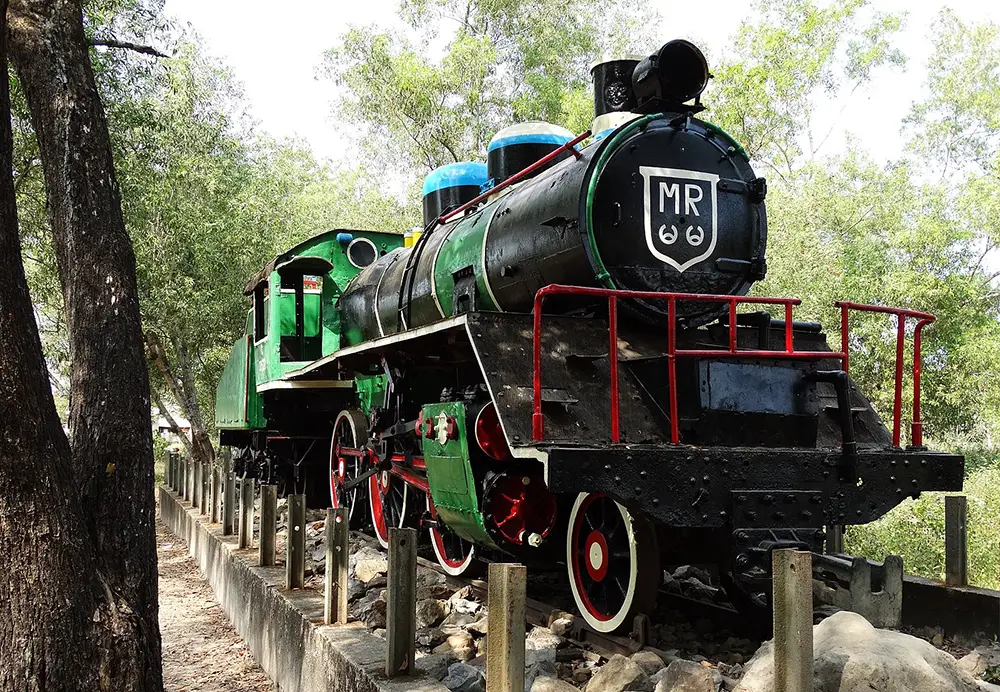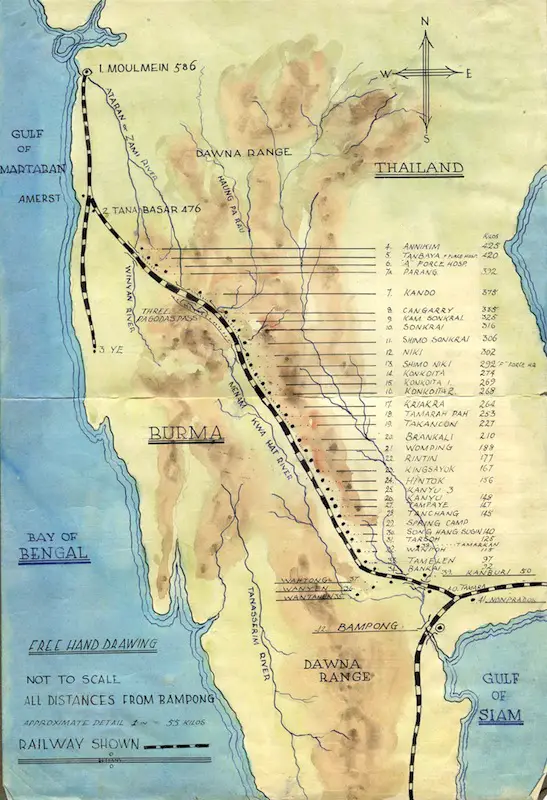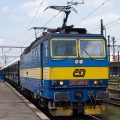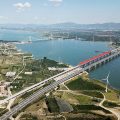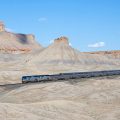The Thai-Burma Railway is one of the more recent famous railways in the world. Although it serves a more positive purpose today, its history is tied closely with tragedy and it is important to remember why it was built and what purpose it served. To ignore its history would be the same as to claim it never really happen.
Here are 25 amazing facts about the Thai-Burma Railway:
Photo source: Wikimedia Commons
#1 – The Thai-Burma Railway was first built in 1942 under the order of the Imperial Japanese Army who was occupying Thailand at that time. This railway was obviously built during World War 2 and was done so to improve the Japanese military’s ability to continue fighting their ongoing brutal Burma Campaign. The construction was key in Japan’s railway strategy for shipping troops and provisions to the frontlines.
#2 – The majority of the track was only in use for one year, between 1942 and 1943. After the war, the governments of Thailand and Myanmar deliberated for a while on whether the railway should be used, despite the tragic circumstances under which it was built. Eventually, only the section from Kanchanaburi to Nam Tok in Thailand was re-opened in 1957.
#3 – The Thai-Burma Railway is not the largest in the world, but it has gained its fame in far more sinister ways. It exists as just 415km of railway between Ban Pong in Thailand and Thanbyuzayat in Burma. It took just 16 months for the entire railway to be built.
#4 – The Thai-Burma Railway is not its only name. It is often commonly also known as the Siam-Burma Railway, the Death Railway or sometimes the Railway of Death.
#5 – Around 180-250,000 Southeast Asian civilians were put to work as forced laborers to build this railway and its many bridges. Additionally, around 61,000 Allied prisoners of war were forced to work in the railway’s labor camps tasked with its construction and maintenance. 90,000 civilians and 12,000 prisoners of war lost their lives because of this forced labor by the Japanese military.
#6 – The reason specifically that a railway was the only option in this area of Asia between Thailand and Burma (Myanmar), was that the Japanese navy had been severely weakened in the Coral Sea. Without the firepower needed for safe shipping, this became the only option they saw available. Without a protected coastline, building the railway through the jungles and over the rivers of Thailand and Burma was decided by the Japanese government to be the only choice.
#7 – The number of laborers needed to build this rail so quickly (just 16 months), meant that the Japanese had to decide between using soldiers or forced labor. They decided on forced labor, to save resources. Forced laborers do not require the food, medicine and rest that conscripted soldiers do. It has gone down as one of the wars’ terrible crimes and many of the orchestrators were sentenced to death over their role in the treatment of these laborers.
#8 – There is a very famous, Oscar award-winning, movie called “The Bridge Over the River Kwai” that you may have heard of. The movie is based on the accounts of several prisoners who were forced to work in these labor camps. On not just the bridge, but the whole railway. The movie gives a very vivid account of what the conditions were like for the workers, and the hardships they faced. An excellent fictional account by Pierre Boule, The Bridge Over the River Kwai: A Novel, follows the ordeal and the human strength of the British POW in the forced labor camp.
#9 – The bridge over the River Kwai is actually still in use today. You can take historical tours along its tracks. This bridge, located in Kanchanaburi Province, along with several other less famous ones, is part of the tour. Whether you are a railway enthusiast, history buff, or even if you are a bit of both, this is a journey that you will remember for the rest of your life.
Photo source: Wikimedia Commons
#10 – The track is a much smaller gauge than many of the more modern rails. Whilst Europe uses a 1,435mm gauge track, the Thai-Burma tracks Gauge was only 1,000mm. This unique size meant that only Japanese trains and cars would work on the rail if control of it was lost.
#11 – The Japanese military only managed to control their new railway for just over a year. During this time they used it to ship approximately 500,000 tones of freight before Allied forces relieved them of ownership.
#12 – Most of the prisoners of war that became forced laborers on the railway were from Australia, the United Kingdom, and India. They largely arrived in Burma as prisoners from the fall of Singapore when British rule was overrun by the Japanese.
#13 – The Thai-Burma Railway was not built in a convenient location at all. In order to get from A to B they had to build around 600 individual bridges. Keep in mind the whole track is only 415km long, that means there was about a bridge every 700 meters.
#14 – Most modern bridges are built from a mix of metal and stone, and even as far back as wartime this was still the norm. Since it was impossible to ship the raw materials needed for a bridge, the laborers were forced to build their bridges almost entirely out of wood. This makes the Thai-Burma Railway particularly unique.
Experience the today’s train ride through this travel video:
Video Credit: Christine Kaaloa – Click Here to watch directly on YouTube
#15 – Building bridges requires heavy machinery and high-quality tools. None of these were provided to the forced laborers. They had to make do with mostly just their hands and the most very basic tools such as spades and hammers. This huge increase in difficulty for what was already not an easy task contributed to how many people lost their lives in the construction of this railway.
#16 – Although the Thai section of the railway was built by the Japanese and existed in Thailand, it was actually owned by the British. The British commandeered it during the war and maintained control of it for many years, before finally selling it to the Thai government. The railway was sold for 50 million Thai Baht, which when converted to American dollars, is about $1.65 million.
#17 – When completed, the Thai-Burma Railway was home to 63 different named stations. Not all of these stations exist today, however, as many were destroyed or just fell into disuse. Because of the circumstances behind their construction, whether or not they should be used, left as shrines, or destroyed completely has been a point of contention for the local populace and governing bodies.
#18 – By the end of the war, only 100 of the 142 original trains that were used on this railway remained in operation. Today, only a handful remain and are purely used for historical tours, or as centerpieces in museums and memorials about the construction of this railway.
#19 – The Thai-Burma Railway has a pretty unique price model for their tickets. Unlike many railways that charge different prices depending on how far you travel, what time, or in what class, the ticket price is always the same. It costs 100 Thai Baht no matter where you get on or off up and down the Thai-Burma railway. That’s about three US dollars for comparison. A pretty good deal for tourists.
#20 – Many of the civilian workers on the project were actually volunteer Malaysian laborers. They were tricked into coming to work on the project with the promise of good pay and food, but they were obviously deceived. Once they arrived, they were threatened with the promise of death if they tried to leave.
Photo source: Changi POW Art
#21 – Although the famous film, “The Bridge Over the River Kwai“, was based on this railway entirely, and specifically that bridge, they actually chose not to film on location. Some shots of the bridge exist in the film, but most of the film was actually shot in Sri Lanka. This was out of respect and out of convenience for the local population. Filming around such an important local monument, especially one so busy, is not ideal.
#22 – One of the biggest threats to the worker’s wellbeing was not just exhaustion and beatings by the Japanese guards, it was the jungle itself. Even today, as it was back then, the route of the railway was heavily populated by mosquitos. They spread disease and with the intentional lack of medicine in the POW camp, this often led to the laborers dying of otherwise preventable diseases. If you plan to visit today, make sure you bring bug spray.
#23 – There are plans to expand the railway routes and even revitalize some of the older ones. It is not an easy undergoing and there is a lot of controversy surrounding using track and bridges built by POWs during the war.
#24 – Although it has been so long since the end of World War 2, the people of Malaysia and other surrounding Southeast Asian countries who had their population forced into these work camps are still waiting on reparations from the Japanese government. Some are waiting for just an apology, some even just an acknowledgment.
#25 – The Hellfire Pass is one of the more well known atrocities to occur on this railway. The Hellfire Pass was also the most difficult section of the railway to build. A huge rocky section was directly in the track’s way and could not be avoided. There were two real options: build a tunnel, or carve all of the rock out from the mountain. The Japanese military leaders overseeing the project chose to cut the rock out. Cutting out such a huge amount of solid stone required the workers to be on the job for 18 hours a day. Over the 6 weeks that it took to carve it out completely, 69 prisoners of war were beaten to death as forms of punishment or twisted encouragement. Hundreds more died from cholera and other such illnesses.
The Thai-Burma Railway has a dark history, its past is not pleasant and is absolutely not something that we should ever be allowed to forget. Being able to visit this historic railway, travel on its trains and view its many bridges and memorials is a privilege not many people are lucky enough to have. If you do get to visit, take your time to appreciate what happened during the war, and what has been done since to make use of the railway again. Whether you think that the entire railway line should be reopened or not is up to you.
You might also like the following facts about the best railway journeys in the world:
- 25 Amazing Facts About the Euro Rail & Eurail
- 25 Amazing Facts About the Shinkansen, the Japanese Bullet Train
- 25 Amazing Facts About the Trans-Siberian Railway
- 25 Amazing Facts About the Amtrak Railway
- 25 Amazing Facts About the Orient Express
- 25 Amazing Facts About the Bangkok-Ayutthaya Railway
- 25 Amazing Facts About the Trans-Mongolian Railway
- 25 Amazing Facts About the Beijing-Lhasa Railway

